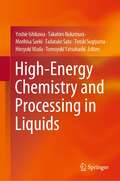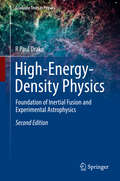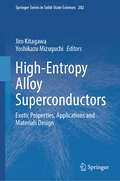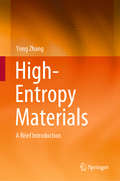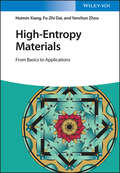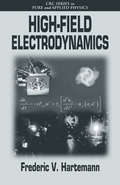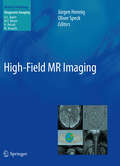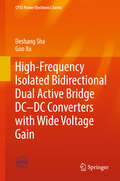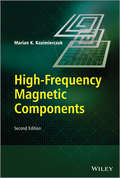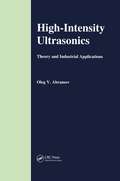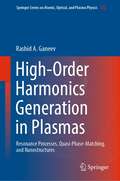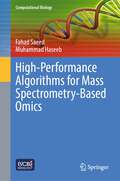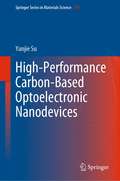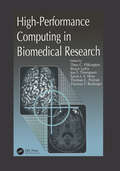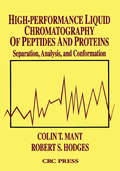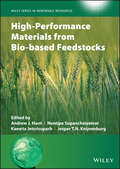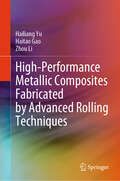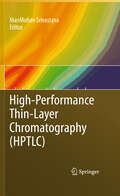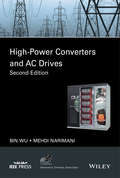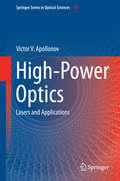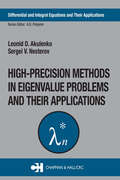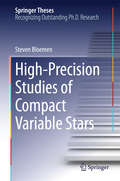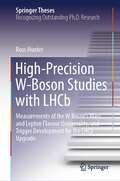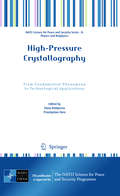- Table View
- List View
High-Energy Chemistry and Processing in Liquids
by Yoshie Ishikawa Takahiro Nakamura Morihisa Saeki Tadatake Sato Teruki Sugiyama Hiroyuki Wada Tomoyuki YatsuhashiThis book focuses on chemical reactions and processing under extreme conditions—how materials react with highly concentrated active species and/or in a very confined high-temperature and high-pressure volume. Those ultimate reaction environments created by a focused laser beam, discharges, ion bombardments, or microwaves provide characteristic nano- and submicron-sized products and functional nanostructures. The book explores the chemistry and processing of metals and non-metals as well as molecules that are strongly dependent on the energy deposition processes and character of the materials. Descriptions of a wide range of topics are given from the perspective of a variety of research methodologies, material preparations, and applications. The reader is led to consider and review how a high-energy source interacts with materials, and what the key factors are that determine the quality and quantity of nanoproducts and nano-processing.
High-Energy Ecologically Safe HF/DF Lasers: Physics of Self-Initiated Volume Discharge-Based HF/DF Lasers
by Victor V. Apollonov Sergey Yu. KazantsevThis book explores new principles of Self-Initiating Volume Discharge for creating high-energy non-chain HF(DF) lasers, as well as the creation of highly efficient lasers with output energy and radiation power in the spectral region of 2.6–5 μm. Today, sources of high-power lasing in this spectral region are in demand in various fields of science and technology including remote sensing of the atmosphere, medicine, biological imaging, precision machining and other special applications. These applications require efficient laser sources with high pulse energy, pulsed and average power, which makes the development of physical fundamentals of high-power laser creation and laser complexes of crucial importance. High-Energy Ecologically Safe HF/DF Lasers: Physics of Self-Initiated Volume Discharge-Based HF/DF Lasers examines the conditions of formation of SSVD, gas composition and the mode of energy input into the gas on the efficiency and radiation energy of non-chain HF(DF) lasers. Key Features: Shares research results on SSVD in mixtures of non-chain HF(DF) lasers Studies the stability and dynamics of the development of SSVD Discusses the effect of the gas composition and geometry of the discharge gap (DG) on its characteristics Proposes recommendations for gas composition and for the method of obtaining SSVD in non-chain HF(DF) lasers Develops simple and reliable wide-aperture non-chain HF(DF) lasers and investigates their characteristics Investigates the possibilities of expanding the lasing spectrum of non-chain HF(DF) lasers
High-Energy-Density Physics
by R Paul DrakeThis book has two goals. One goal is to provide a means for those new to high-energy-density physics to gain a broad foundation from one text. The second goal is to provide a useful working reference for those in the ?eld. This book has at least four possible applications in an academic c- text. It can be used for training in high-energy-density physics, in support of the growing number of university and laboratory research groups working in this area. It also can be used by schools with an emphasis on ultrafast lasers, to provide some introduction to issues present in all laser-target - perimentswithhigh-powerlasers,andwiththoroughcoverageofthematerial in Chap. 11 on relativistic systems. In addition, it could be used by physics, applied physics, or engineering departments to provide in a single course an introduction to the basics of ?uid mechanics and radiative transfer, with d- matic applications. Finally, it could be used by astrophysics departments for a similar purpose, with the parallel bene?t of training the students in the similarities and di?erences between laboratory and astrophysical systems. The notation in this text is deliberately sparse and when possible a given symbol has only one meaning. A de?nition of the symbols used is given in Appendix A. In various cases, additional subscripts are added to distinguish among cases of the same quantity, as for example in the use of ? and ? 1 2 to distinguish the mass density in two di?erent regions.
High-Entropy Alloy Superconductors: Exotic Properties, Applications and Materials Design (Springer Series in Solid-State Sciences #202)
by Jiro Kitagawa Yoshikazu MizuguchiThis book offers a comprehensive survey of the latest research concerning high-entropy alloy (HEA) superconductors, an emerging topic which has attracted significant attention since their discovery in 2014. HEAs represent a novel class of materials introduced in 2004, renowned for their exceptional mechanical attributes, robust resistance to corrosion, and remarkable thermal stability, among other characteristics. Superconductivity has emerged as a particularly prominent subject in this domain. Recent important findings are robust superconductivity under extraordinarily high pressure or ion irradiation, possible unconventional superconductivity, enhancement of bulk superconductivity, and high critical current density. In this book, HEA superconductors are classified into two primary categories: The first class encompasses alloy systems characterized by body-centered cubic and hexagonal close-packed structures; and the second class comprises intermetallic types. In each of these classes, the authors expound upon the exotic properties, applications, and materials design, aligning with the overarching themes of their work. This book delivers a topical and timely discussion of superconductivity associated with the high-entropy state, the potential applications under consideration, and the intricacies of materials design. These recent discoveries are poised to captivate many researchers in materials science, particularly those engaged in high-entropy alloys and the realm of superconducting properties and technology.
High-Entropy Materials: A Brief Introduction
by Yong ZhangThis book draws on the latest research to discuss the history and development of high-entropy alloys and ceramics in bulk, film, and fiber form. High-entropy materials have recently been developed using the entropy of mixing and entropy of configuration of materials, and have proven to exhibit unique properties superior to those of conventional materials. The field of high-entropy alloys was born in 2004, and has since been developed for both scientific and engineering applications. Although there is extensive literature, this field is rapidly transforming. This book highlights the cutting edge of high-entropy materials, including their fundamentals and applications. Above all, it reflects two major milestones in their development: the equi-atomic ratio single-phase high-entropy alloys; and the non-equi-atomic ratio dual-phase high-entropy alloys.
High-Entropy Materials: From Basics to Applications
by Yanchun Zhou Huimin Xiang Fu-Zhi DaiHigh-Entropy Materials Significant update of knowledge in the field of high-entropy materials, including promising new high-entropy ceramics High-Entropy Materials provides information on state-of-the-art development in the field of high-entropy materials, including high-entropy alloys, high-entropy ceramics, and a variety of their applications, covering many core topics to provide a thorough and detailed overview of the subject. The book also thoroughly explores the applications of high-entropy materials in various areas, such as EBC/TBC coating, superhard and wear resistance coating, nuclear energy, batteries, catalysts, thermoelectric, supercapacitors, biocompatible structure, and microelectronics. In High-Entropy Materials, readers can expect to find specific information on: Basics of high entropy materials, structural features and thermodynamics of high-entropy materials, and theoretical design in high-entropy materials Synthesis and processing of high-entropy materials and characterization of high-entropy materials, as well as their mechanical and functional properties Challenges and future directions of high-entropy materials, a relatively new type of material that has been in development only since the early 2000s How high-entropy materials are a horizon-broadening class of materials that can significantly further humanity’s pursuit of progress Focusing on the fundamentals and developments of high-entropy alloys and ceramics as well as on their microstructure and properties for a wide range of applications, High-Entropy Materials is an essential resource on the subject for materials scientists, metallurgists, mechanical engineers, and professionals in the aerospace industries.
High-Field Electrodynamics (Pure and Applied Physics)
by Frederic V. HartemannTremendous technological developments and rapid progress in theory have opened a new area of modern physics called high-field electrodynamics: the systematic study of the interaction of relativistic electrons or positrons with ultrahigh-intensity, coherent electromagnetic radiation. This advanced undergraduate/graduate-level text provides a
High-Field MR Imaging
by Oliver Speck Jürgen HennigThis book describes the current status of the very rapidly developing field of high-field MR and examines the possibilities, challenges, and limitations of this fascinating technology. In the initial chapters, the basic technological background is explained in a non-technical way so as to promote understanding of the issues and concepts and avoid overwhelming the reader with excessive detail. Safety issues, methods, and contrast are then carefully considered. The final part of the book examines the diverse applications of high-field MR imaging in radiology, neuroscience, oncology, and other fields, with the aid of numerous high-quality illustrations. All chapters are written by leading experts who have taken great care to illustrate the potential and progress of the field in an informative and accessible manner. The book will appeal to all with a potential interest in the application of high-field MR imaging, including radiologists, neuroscientists, and oncologists.
High-Frequency Isolated Bidirectional Dual Active Bridge DC–DC Converters with Wide Voltage Gain (Cpss Power Electronics Ser.)
by Deshang Sha Guo XuWritten by experts, this book is based on recent research findings in high-frequency isolated bidirectional DC-DC converters with wide voltage range. It presents advanced power control methods and new isolated bidirectional DC-DC topologies to improve the performance of isolated bidirectional converters. Providing valuable insights, advanced methods and practical design guides on the DC-DC conversion that can be considered in applications such as microgrid, bidirectional EV chargers, and solid state transformers, it is a valuable resource for researchers, scientists, and engineers in the field of isolated bidirectional DC-DC converters.
High-Frequency Magnetic Components
by Marian K. KazimierczukA unique text on the theory and design fundaments of inductors and transformers, updated with more coverage on the optimization of magnetic devices and many new design examplesThe first edition is popular among a very broad audience of readers in different areas of engineering and science. This book covers the theory and design techniques of the major types of high-frequency power inductors and transformers for a variety of applications, including switching-mode power supplies (SMPS) and resonant dc-to-ac power inverters and dc-to-dc power converters. It describes eddy-current phenomena (such as skin and proximity effects), high-frequency magnetic materials, core saturation, core losses, complex permeability, high-frequency winding resistance, winding power losses, optimization of winding conductors, integrated inductors and transformers, PCB inductors, self-capacitances, self-resonant frequency, core utilization factor area product method, and design techniques and procedures of power inductors and transformers. These components are commonly used in modern power conversion applications. The material in this book has been class-tested over many years in the author's own courses at Wright State University, which have a high enrolment of about a hundred graduate students per term. The book presents the growing area of magnetic component research in a textbook form, covering the foundations for analysing and designing magnetic devices specifically at high-frequencies. Integrated inductors are described, and the Self-capacitance of inductors and transformers is examined. This new edition adds information on the optimization of magnetic components (Chapter 5). Chapter 2 has been expanded to provide better coverage of core losses and complex permeability, and Chapter 9 has more in-depth coverage of self-capacitances and self-resonant frequency of inductors. There is a more rigorous treatment of many concepts in all chapters. Updated end-of-chapter problems aid the readers' learning process, with an online solutions manual available for use in the classroom.Provides physics-based descriptions and models of discrete inductors and transformers as well as integrated magnetic devicesNew coverage on the optimization of magnetic devices, updated information on core losses and complex permeability, and more in-depth coverage of self-capacitances and self-resonant frequency of inductorsMany new design examples and end-of-chapter problems for the reader to test their learningPresents the most up-to-date and important references in the fieldUpdated solutions manual, now available through a companion websiteAn up to date resource for Post-graduates and professors working in electrical and computer engineering. Research students in power electronics. Practising design engineers of power electronics circuits and RF (radio-frequency) power amplifiers, senior undergraduates in electrical and computer engineering, and R & D staff.
High-Intensity Ultrasonics: Theory and Industrial Applications
by OV AbramovThis book presents a comprehensive description of the theory and physics of high-intensity ultrasound, as well as dealing with a wide range of problems associated with the industrial applications of ultrasound, mainly in the areas of metallurgy and mineral processing. The book is divided into three sections, with Part I introducing the reader to the theory and physics of high-intensity ultrasound. Topics in this section include the propagation of ultrasound in liquid media and related nonlinear phenomena, metal crystallization in an ultrasonic field, ultrasound propagation in solids, alterations in dislocational structure, and ultrasonic effects on solidified metal. In Part II the design of ultrasonic generators, mechanoacoustic radiators and other vibrational systems is considered, as well as the control of acoustic parameters when vibrations are passed into a processed medium. Part lll describes problems associated with various uses of high-intensity ultrasound in metallurgy, for example ore dressing or producing powders and cast composites. The applications of high-intensity ultrasound for metal shaping, thermal and thermochemical treatment, welding, cutting, refining, and surface hardening are also discussed here. This comprehensive monograph provides an invaluable source of information, which has been largely unavailable in the West until now. The author is very well known and respected internationally within the field of ultrasonics.
High-Order Harmonics Generation in Plasmas: Resonance Processes, Quasi-Phase-Matching, and Nanostructures (Springer Series on Atomic, Optical, and Plasma Physics #122)
by Rashid A. GaneevThis book comprises a detailed consideration of novel approaches developed in the field of frequency conversion of laser sources in laser-induced plasmas during the last few years. The aim of the book is to support researchers and other readers in their development in the area of high-order nonlinear spectroscopy. Particularly, the advanced studies of nanoparticles and quantum dots for the formation of new sources of radiation in different short-wavelength spectral ranges show the ways to further implement the specific features of small-sized species in a relatively new field of study—laser ablation induced high-order harmonics generation spectroscopy.Researchers involved in the development of new methods of frequency conversion will benefit from finding the most recent advances in this field. Undergraduate students will discover interesting information about recent findings in plasma harmonic research. Additionally, the usefulness of the book will be demonstrated by the potential applications of the new knowledge developed during recent years for ultrafast pulse generation using the proposed schemes of plasma-light interaction. Thus, the audience may also include those researchers involved in state-of-the-art developments in attophysics. Additionally, any professionals interested in the application of the advanced techniques for material science will also benefit from updating their knowledge of new methods of material studies using high-order nonlinear spectroscopy.
High-Performance Algorithms for Mass Spectrometry-Based Omics (Computational Biology)
by Fahad Saeed Muhammad HaseebTo date, processing of high-throughput Mass Spectrometry (MS) data is accomplished using serial algorithms. Developing new methods to process MS data is an active area of research but there is no single strategy that focuses on scalability of MS based methods. Mass spectrometry is a diverse and versatile technology for high-throughput functional characterization of proteins, small molecules and metabolites in complex biological mixtures. In the recent years the technology has rapidly evolved and is now capable of generating increasingly large (multiple tera-bytes per experiment) and complex (multiple species/microbiome/high-dimensional) data sets. This rapid advance in MS instrumentation must be matched by equally fast and rapid evolution of scalable methods developed for analysis of these complex data sets. Ideally, the new methods should leverage the rich heterogeneous computational resources available in a ubiquitous fashion in the form of multicore, manycore, CPU-GPU, CPU-FPGA, and IntelPhi architectures. The absence of these high-performance computing algorithms now hinders scientific advancements for mass spectrometry research. In this book we illustrate the need for high-performance computing algorithms for MS based proteomics, and proteogenomics and showcase our progress in developing these high-performance algorithms.
High-Performance Carbon-Based Optoelectronic Nanodevices (Springer Series in Materials Science #319)
by Yanjie SuThis book focuses on the photoelectric nanodevices based on carbon nanostructures, such as carbon nanotubes, graphene and related heterojunctions. The synthesis of carbon nanostructures and device fabrication are simply given. The interface charge transfer and the performance enhancement in the photodetectors and solar cells are comprehensively introduced. Importantly, carbon allotropes behave as high-mobility conductors or bandgap-tunable semiconductors depending on the atomic arrangements, the direct motivation is to fabricate all-carbon nanodevices using these carbon nanomaterials as building blocks. The photoelectric nanodevices based on all-carbon nanostructures have increasingly attracted attention in the future.The book offers a valuable reference guide to carbon-based photoelectric devices for researchers and graduate school students in the field. It will also benefit all researchers who investigate photoelectric nanodevices and photoelectric conversion with relevant frontier theories and concepts.
High-Performance Computing in Biomedical Research
by Theo C. Pilkington Bruce Loftis Thomas Palmer Thomas F. BudingerLeading researchers have contributed state-of-the-art chapters to this overview of high-performance computing in biomedical research. The book includes over 30 pages of color illustrations. Some of the important topics featured in the book include the following:
High-Performance Liquid Chromatography of Peptides and Proteins: Separation, Analysis, and Conformation
by Colin T. Mant and Robert S. HodgesThis book consists of a series of 82 precise, easy-to-read articles by internationally renowned scientists and emphasizes the practical approach to HPLC with minimal theory, although the underlying principles for peptide and protein separations are clearly expressed. All of the major modes of microbore, ultrafast and analytical HPLC are discussed, including size-exclusion, ion-exchange, reversed-phase, hydrophobic interaction, and affinity and immunoaffinity chromatography. A section on preparative HPLC, including displacement techniques, is also presented. Problem-solving approaches to the separation of various classes of biologically active peptides and proteins are thoroughly explored, while the importance of peptide standards for monitoring column performance and for optimizing separation conditions is emphasized. Several articles focus on the choice of the correct detection method (electrochemical, UV, fluorescence), as well as the need for a proper knowledge of approaches to column and instrument maintenance and trouble-shooting. A section on predictive approaches deals with both computer simulation of peptide separations and peptide structure. The book also includes complementary techniques to HPLC, as well as other useful applications of HPLC. It enables both novice and experienced chromatographers to realize the full potential of this extremely powerful technique, in the process making an important contribution to scientific literature.
High-Performance Materials from Bio-based Feedstocks (Wiley Series in Renewable Resource)
by Christian V. StevensHigh-Performance Materials from Bio-based Feedstocks High-Performance Materials from Bio-based Feedstocks The latest advancements in the production, properties, and performance of bio-based feedstock materials In High-Performance Materials from Bio-based Feedstocks, an accomplished team of researchers delivers a comprehensive exploration of recent developments in the research, manufacture, and application of advanced materials from bio-based feedstocks. With coverage of bio-based polymers, the inorganic components of biomass, and the conversion of biomass to advanced materials, the book illustrates the research and commercial potential of new technologies in the area. Real-life applications in areas as diverse as medicine, construction, synthesis, energy storage, agriculture, packaging, and food are discussed in the context of the structural properties of the materials used. The authors offer deep insights into materials production, properties, and performance. Perfect for chemists, environmental scientists, engineers, and materials scientists, High-Performance Materials from Bio-based Feedstocks will also earn a place in the libraries of academics, industrial researchers, and graduate students with an interest in biomass conversion, green chemistry, and sustainability. A thorough introduction to the latest developments in advanced bio-based feedstock materials research Comprehensive explorations of a vast range of real-world applications, from tissue scaffolds and drug delivery to batteries, sorbents, and controlled release fertilizers Practical discussions of the organic and inorganic components of biomass and the conversion of biomass to advanced materials In-depth examinations of the structural properties of commercially and academically significant biomass materials For more information on the Wiley Series in Renewable Resources, visit www.wiley.com/go/rrs
High-Performance Metallic Composites Fabricated by Advanced Rolling Techniques
by Zhou Li Hailiang Yu Haitao GaoThis book summarizes recent efforts and advances in the roll bonding of metal laminates to reveal the potential mechanism. Based on the comprehensive understanding and our numerous original works, some important issues about the fabrication method, evolution mechanism of bonding interface and reinforcement factors of roll-bonded metal laminates are discussed and emphasized. Furthermore, some prospective viewpoints about the design, fabrication and fracture mechanism of roll-bonded metal laminates are proposed.
High-Performance Thin-Layer Chromatography (HPTLC)
by Manmohan SrivastavaThe present edited book is the presentation of 18 in-depth national and international contributions from eminent professors, scientists and instrumental chemists from educational institutes, research organizations and industries providing their views on their experience, handling, observation and research outputs on HPTLC, a multi-dimensional instrumentation. The book describes the recent advancements made on TLC which have revolutionized and transformed it into a modern instrumental technique HPTLC. The book addresses different chapters on HPTLC fundamentals: principle, theory, understanding; instrumentation: implementation, optimization, validation, automation and qualitative and quantitative analysis; applications: phytochemical analysis, biomedical analysis, herbal drug quantification, analytical analysis, finger print analysis and potential for hyphenation: HPTLC future to combinatorial approach, HPTLC-MS, HPTLC-FTIR and HPTLC-Scanning Diode Laser. The chapters in the book have been designed in such away that the reader follows each step of the HPTLC in logical order.
High-Power Converters and AC Drives
by Bin Wu Mehdi NarimaniA comprehensive reference of the latest developments in MV drive technology in the area of power converter topologies This new edition reflects the recent technological advancements in the MV drive industry, such as advanced multilevel converters and drive configurations. It includes three new chapters, Control of Synchronous Motor Drives, Transformerless MV Drives, and Matrix Converter Fed Drives. In addition, there are extensively revised chapters on Multilevel Voltage Source Inverters and Voltage Source Inverter-Fed Drives. This book includes a systematic analysis on a variety of high-power multilevel converters, illustrates important concepts with simulations and experiments, introduces various megawatt drives produced by world leading drive manufacturers, and addresses practical problems and their mitigations methods. This new edition: Provides an in-depth discussion and analysis of various control schemes for the MV synchronous motor drives Examines new technologies developed to eliminate the isolation transformer in the MV drives Discusses the operating principle and modulation schemes of matrix converter (MC) topology and multi-module cascaded matrix converters (CMCs) for MV drives, and their application in commercial MV drives Bin Wu is a Professor and Senior NSERC/Rockwell Automation Industrial Research Chair in Power Electronics and Electric Drives at Ryerson University, Canada. He is a fellow of Institute of Electrical and Electronics Engineers (IEEE), Engineering Institute of Canada (EIC), and Canadian Academy of Engineering (CAE). Dr. Wu has published more than 400 papers and holds more than 30 granted/pending US/European patents. He co-authored several books including Power Conversion and Control of Wind Energy Systems and Model Predictive Control of Wind Energy Conversion Systems (both by Wiley-IEEE Press). Mehdi Narimani is a Postdoctoral Research Associate with the Department of Electrical and computer Engineering at Ryerson University, Canada, and Rockwell Automation Canada. He is a senior member of IEEE. Dr. Narimani is author/co-author of more than 50 technical papers and four US/European patents (issued/pending review). His current research interests include power conversion, high power converters, control of power electronics, and renewable energy systems.
High-Power Optics
by Victor V. ApollonovThis book covers the basics, realization and materials for high power laser systems and high power radiation interaction with matter. The physical and technical fundamentals of high intensity laser optics and adaptive optics and the related physical processes in high intensity laser systems are explained. A main question discussed is: What is power optics? In what way is it different from ordinary optics widely used in cameras, motion-picture projectors, i. e. , for everyday use? An undesirable consequence of the thermal deformation of optical elements and surfaces was discovered during studies of the interaction with powerful incident laser radiation. The requirements to the fabrication, performance and quality of optical elements employed within systems for most practical applications are also covered. The high-power laser performance is generally governed by the following: (i) the absorption of incident optical radiation (governed primarily by various absorption mechanisms), (ii) followed by a temperature increase and response governed primarily by thermal properties and (iii) the thermo-optical and thermo-mechanical response of distortion, stress, fracture, etc. All this needs to be understood to design efficient, compact, reliable and useful high power systems for many applications under a variety of operating conditions, pulsed, continuous wave and burst mode of varying duty cycles. The book gives an overview of an important spectrum of related topics like laser resonator configurations, intermetallic optical coatings, heat carriers for high power optics, cellular materials, high-repetition-rate lasers and mono-module disk lasers for high power optics.
High-Precision Methods in Eigenvalue Problems and Their Applications
by Leonid D. Akulenko Sergei V. NesterovThis book presents a survey of analytical, asymptotic, numerical, and combined methods of solving eigenvalue problems. It considers the new method of accelerated convergence for solving problems of the Sturm-Liouville type as well as boundary-value problems with boundary conditions of the first, second, and third kind. The authors also present high
High-Precision Studies of Compact Variable Stars
by Steven BloemenThis book, which is a reworked and updated version of Steven Bloemen's original PhD thesis, reports on several high-precision studies of compact variable stars. Its strength lies in the large variety of observational, theoretical and instrumentation techniques that are presented and used and paves the way towards new and detailed asteroseismic applications of single and binary subdwarf stars. Close binary stars are studied using high cadence spectroscopic datasets collected with state of the art electron multiplying CCDs and analysed using Doppler tomography visualization techniques. The work touches upon instrumentation, presenting the calibration of a new fast, multi-colour camera installed at the Mercator Telescope on La Palma. The thesis also includes theoretical work on the computation of the temperature range in which stellar oscillations can be driven in subdwarf B-stars. Finally, the highlight of the thesis is the measurement of velocities of stars using only photometric data from NASA's Kepler satellite. Doppler beaming causes stars to appear slightly brighter when they move towards us in their orbits, and this subtle effect can be seen in Kepler's brightness measurements. The thesis presents the first validation of such velocity measurements using independent spectroscopic measurements. Since the detection and validation of this Doppler beaming effect, it has been used in tens of studies to detect and characterize binary star systems, which are key calibrators in stellar astronomy.
High-Precision W-Boson Studies with LHCb: Measurements of the W Boson's Mass and Lepton Flavour Universality, and Trigger Development for the LHCb Upgrade (Springer Theses)
by Ross HunterThis book details a new and ground-breaking contribution to the search for a successor to the Standard Model (SM) of particle physics - the largest modern endeavour in the field. In the hope of seeing a discrepancy with the SM's predictions, this work discusses two hitherto unforeseen measurements at the frontier of experimental precision: a measurement of W-boson mass and a test of the fundamental axiom of the W boson's lepton flavour universality (LFU). Both measurements are made by analysing collision data from the LHCb experiment at the Large Hadron Collider (LHC) at CERN, and represent the establishment of a new field of high-precision Standard Model tests with LHCb. This book also describes the development of new software tools for the optimisation of the LHCb trigger system, which helps to ensure that LHCb's exciting physics program can continue to prosper into the future. This book is accessible to those with graduate—or master's—level training in experimental particle physics.
High-Pressure Crystallography
by Elena Boldyreva Przemyslaw DeraThis book is devoted to the theme of crystallographic studies at high pressure, with emphasis on the phenomena characteristic to the compressed state of matter, as well as experimental and theoretical techniques, used to study these phenomena. As a thermodynamic parameter, pressure is remarkable in many ways. It spans in the visible universe over sixty orders of magnitude, from the non-equilibrium pressure of hydrogen in intergalactic space, to the kind of pressure encountered within neutron stars. In laboratory, it provides unique possibility to control structure and properties of materials, dramatically alter electronic properties, break existing, or form new chemical bonds. This agenda naturally encompasses elements of physics (properties, structure and transformations), chemistry (reactions, transport), materials science (new materials) and engineering (mechanical properties); in addition it has direct applications and implications for geology (minerals in deep Earth environments), planetary sciences, biology and medicine (deep sea ecosystems, membranes, protein and nucleic acid folding, origins of life, deactivation of viruses and toxins). Beyond its specificity, high-pressure science finds direct or indirect (e.g. economic) applications in several fields of modern technology, such as mechanical engineering, optoelectronics and spintronics, nanotechnology, pharmaceutical industry and food processing.
